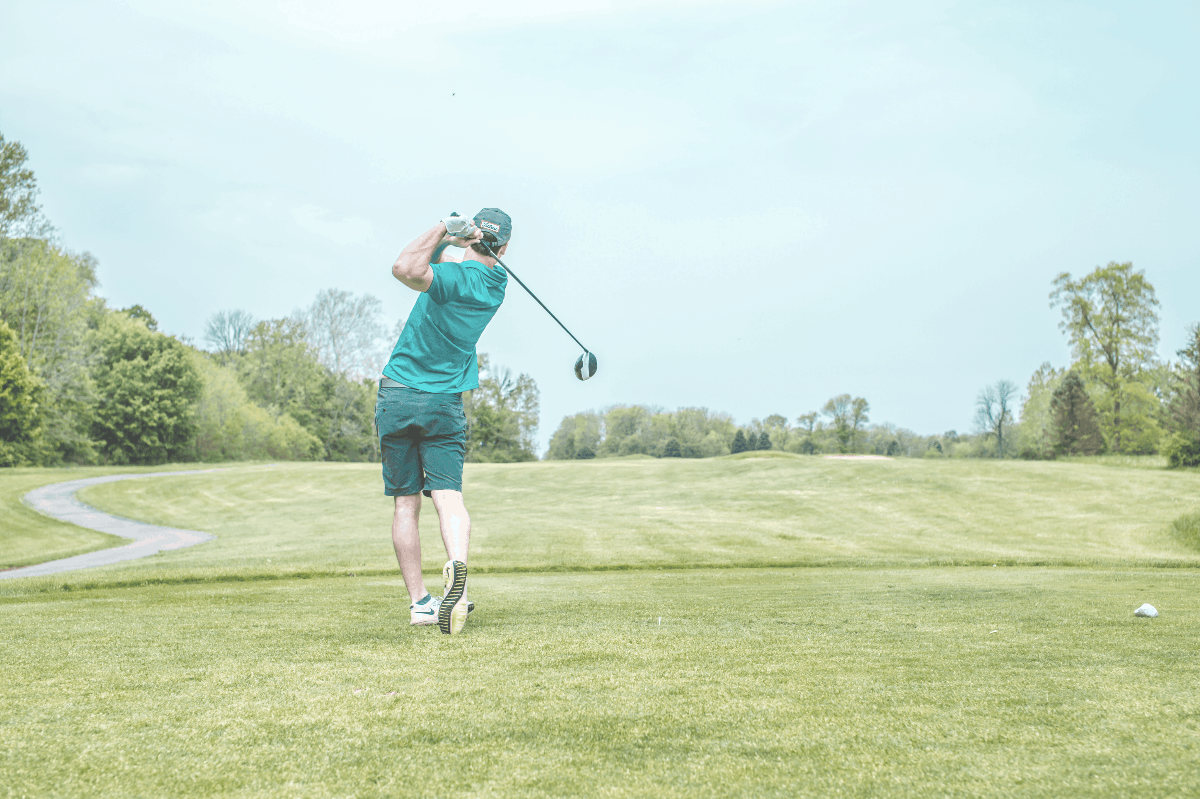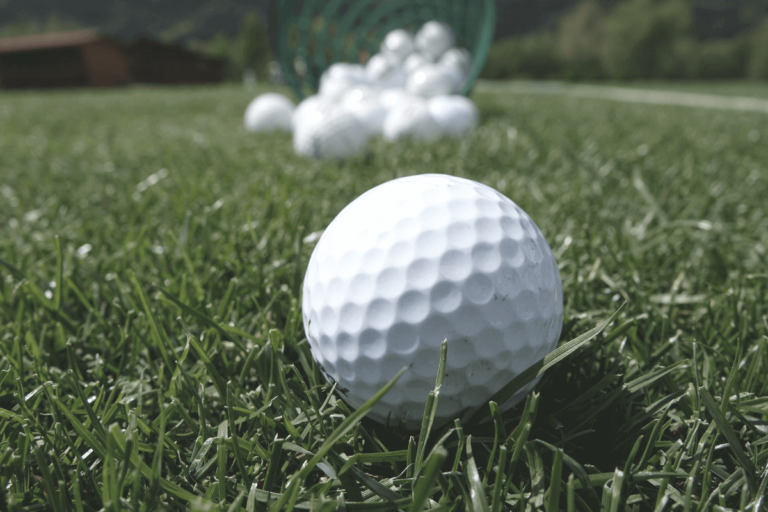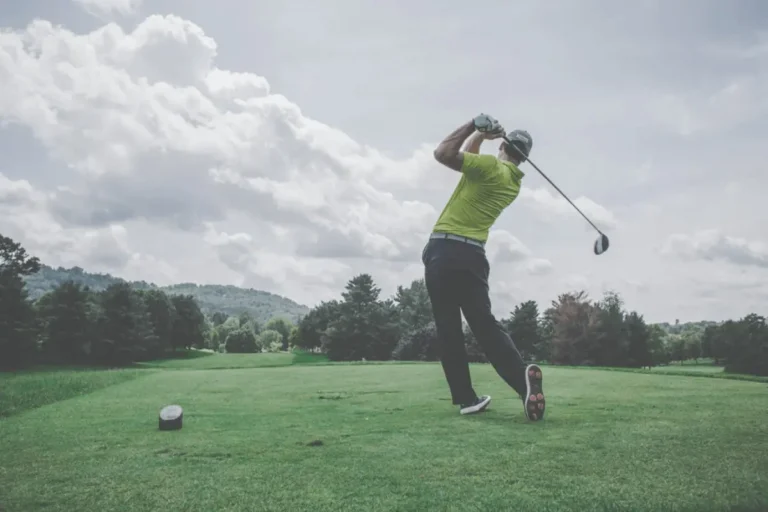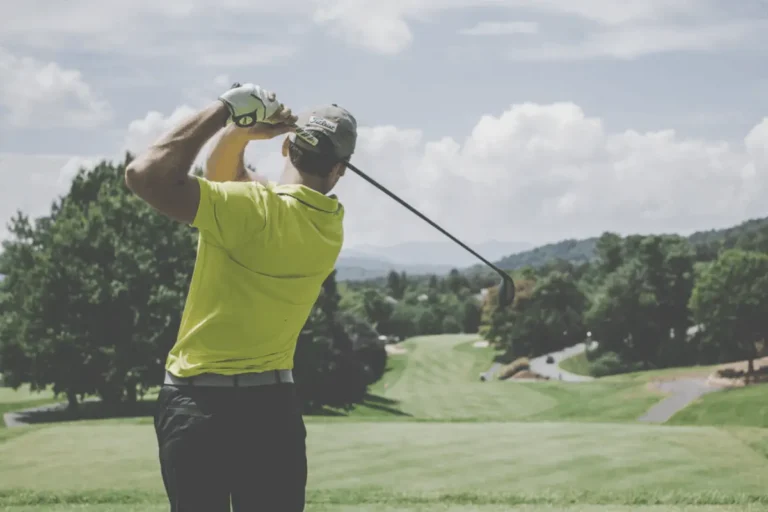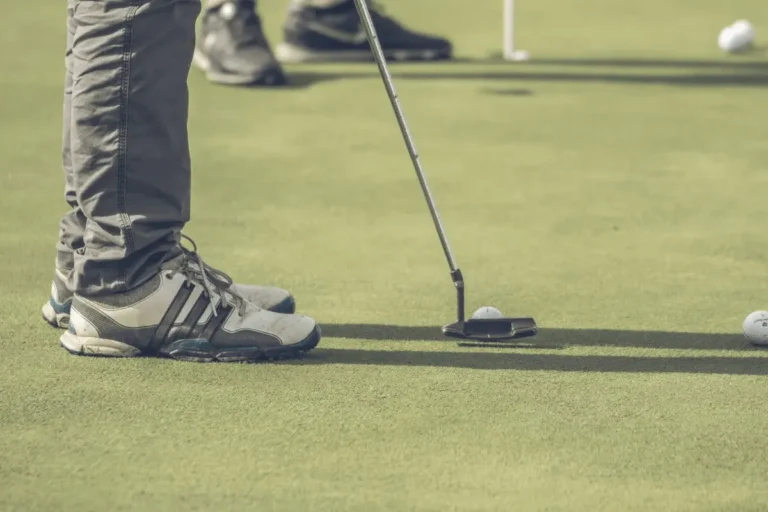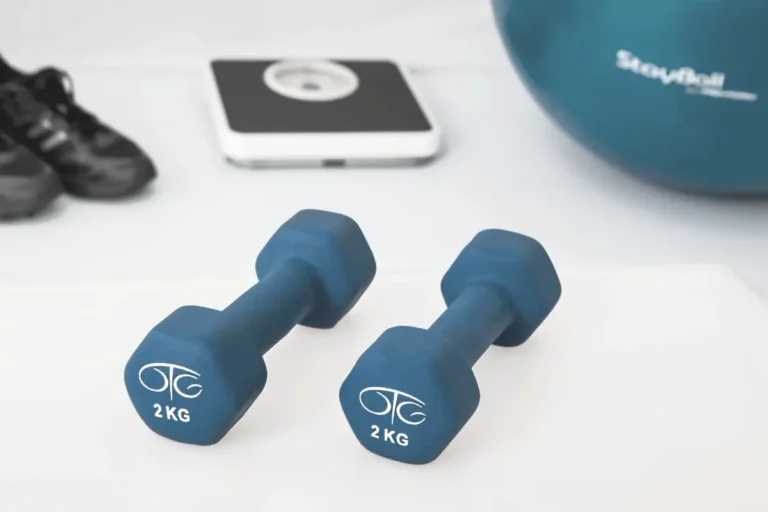How To Perfect Your Golf Swing – easy steps
When I started golfing, I made all the usual mistakes: poor posture, incorrect movement, and no follow-through. The biggest mistake I made, however, was not trusting my swing. This led to weaker shots and even more nerves.
Many amateur golfers face a similar problem, which is why I’ve put together this guide. With my tips, you can learn how to perfect your golf swing and hopefully get over your nerves a lot quicker than I did.
Here, we learn how to perfect your golf swing by:
- Understanding the mechanism of a golf swing
- Mastering your arm movements
- Achieving an excellent stance
- Overcoming any mental roadblocks including performance anxiety
- Improving your takeaway
- Executing proper downswings
The Mechanism of a Golf Swing
Every golf swing is different, but there are a few common elements to consider. Spend some time mastering these and you’ll be on your way to swinging like the pros in no time.
Stance and Grip
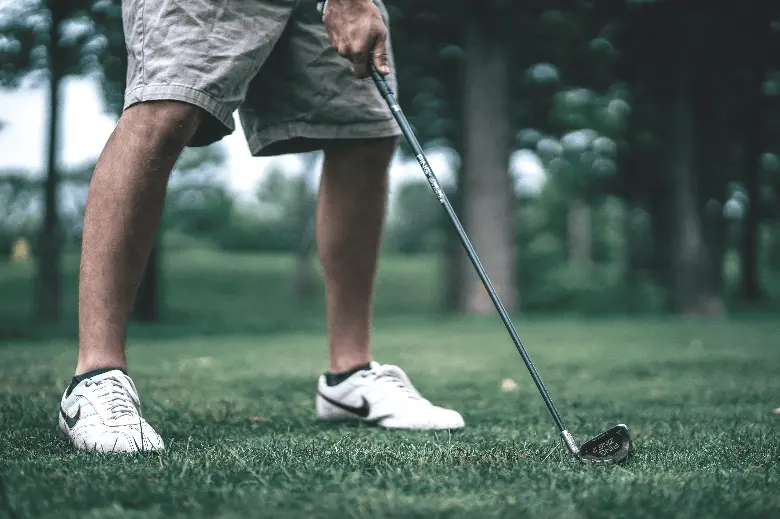
Proper stance and grip are the foundations of any good golf swing.
Balance is the most important thing when it comes to your stance. Make sure you stand in a way that’s comfortable and helps you maintain your balance for your whole swing.
An easy way to do this is to stand naturally and then tilt your upper body forward. This keeps your spine aligned and you’re less likely to injure yourself. It also makes it easier to rotate fully as you swing. Press your feet into the ground to center yourself and maintain your balance.
Most players grip their club in one of three ways: the baseball grip, the interlocking grip, or the overlap grip.
The baseball grip, as you’ve probably guessed, involves holding the club like a baseball bat. While it’s great for speed, it doesn’t give you much control over the ball.
The interlocking grip is one that you’re probably familiar with. It involves interlocking the pinkie finger of your lower hand with the index and middle fingers of your top hand. It’s similar to the overlap grip, where the pinkie finger rests on top of the groove between your index and middle fingers.
These grips give you more control but you need a fair bit of strength to get the same speed as with the baseball grip.
Arm Movement
Your arms might seem like the star of the show when it comes to golf but in reality, a good swing employs your whole body. You’ll use your feet to balance and your hips and core to rotate your upper body. This rotation is where most of your swing range comes from—not your arms.
Don’t get me wrong: your arms do a lot of work when golfing. But if you focus on engaging the rest of your body during your swing, you’ll find that your arms are less tired halfway through the game.
Directing Your Energy

By engaging your entire body, you’ll be able to transfer more energy to your swing. This will create more force when you strike the ball, sending it further.
To do this, you need to transfer energy to your arms and, in turn, your club. The aim is to transfer the energy to the ball on impact. You’ll build momentum on the upswing and speed on the downswing.
For full impact, try slowing your hands just before your club hits the ball. This will cause all that energy to release upon impact. Your ball will go flying with little strain to your body.
The Mental and Physical Aspects of a Golf Swing
It’s important to understand both the mental and physical aspects of golfing as they can influence each other and your golf swing.
Mental Awareness
Many amateur golfers get nervous when they step on the tee and end up overthinking the shot. This can result in a poor swing. Fortunately, there are several techniques you can use to combat this.
First, practice your breathing. It may sound incredibly simple but learning a few basic breathing exercises can help ground you on the golf course. Try inhaling for 4 seconds, holding your breath for 7 seconds, and exhaling for 11 seconds. Repeat this as often as you need to focus your breathing and your mind.
Second, tap into your intent for the swing. Have a clear goal in mind and use this to drive your shot. Take note of your surroundings and visualize what a successful shot looks like. Are you trying to hit the ball as far as you can? Are you honing in on the hole and need a bit more precision?
Trust in your ability and let your body move freely. You’ll be surprised how far thinking like a pro will get you!
Physical Limitations
Understanding your physical limitations is crucial when learning to swing. If you want to swing harder, faster, or further, you need to understand how your body can help you achieve that.
Using your whole body gives you more power and speed. Engage your core and rotate your upper body from your hips and shoulders. This builds momentum on the upswing which will, in turn, generate speed on the downswing. By creating a wide, smooth movement you’ll use less energy and be more consistent.
As I mentioned earlier, it’s important to have a clear goal for every shot you take. This will determine how you line up your shot, position your body, and hold your club. For example, shots with longer clubs like drivers call for a wider stance and baseball grip.
How hard you grip your club also has a huge impact on your swing. Using a neutral grip with your thumbs aligned will force the ball to travel in a straight line. If you want to add distance, try a stronger grip by turning your bottom hand forward.
Perfecting Your Golf Swing
Perfecting your golf swing takes time and practice. The following tips will set you up with an excellent foundation.
Setup and Address
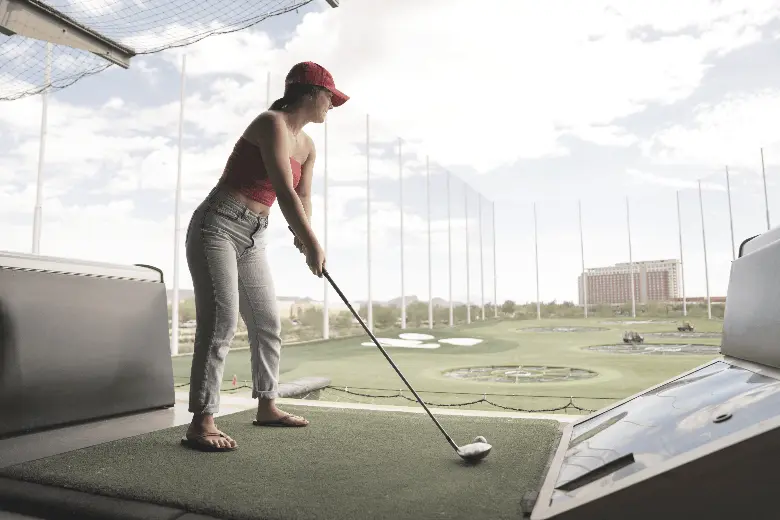
First, let’s position your ball. Make sure it’s in front of you and between your feet. If you’re using a short iron, place it in the middle of your feet. For longer clubs, place the ball closer to your front foot.
Stand in a relaxed, athletic position with your feet pressed firmly into the ground. Bend your knees slightly and distribute your weight evenly on both sides. You should feel centered and balanced.
Your stance will depend on your comfort and the length of your club. Longer clubs generally need a wider stance but balance is key here. Make sure you’re comfortable so you don’t fall over while taking your swing!
For straight shots, align your feet so they’re parallel to your target line. For far shots, select a target in the distance such as a tree or bunker and point your feet slightly to the left of this target. This helps you line up your shots perfectly. Position your clubface directly behind your ball, so that it’s perpendicular to your target line.
Grip your club in a way that is comfortable and allows you the level of speed and control you need for your shot. Most golfers prefer the overlap grip when they’re starting out for maximum control. Try starting with a neutral grip and experimenting with stronger and weaker grips as you practice.
Position your hands ahead of the ball so that the shaft of your club is leaning forward a little. This helps you return to the same position when you strike the ball and, in turn, leads to a better shot.
Keep your back straight and angle your shoulders a bit by dipping your right shoulder. Extend your chin so it doesn’t restrict the movement of the rest of your body as you turn and swing.
Improve Your Golf Takeaway
The takeaway is that strange moment between setting up your shot and starting your swing. While it may not feel like a crucial part of your golf swing, it can set you up for success or failure.
To master the takeaway, point your club straight ahead so it’s parallel to your target line. Make sure your clubface is facing the ground at the end of the takeaway. This sets you up for a straight shot that goes the distance.
Try not to hinge your wrists too early, as this could cause a poor shot. Instead, focus on moving your arms and hands from your shoulders as you bring your club into position.
Lastly, keep your hands positioned in front of your chest for the duration of the takeaway. An easy way to remember this is to form an isosceles triangle with your shoulders and the end of your club. As you move your hands, be sure to move the rest of your upper body to keep the triangle intact.
Improve Your Backswing
Many golfers think that bending their elbow during the backswing results in more speed and force. In fact, to get the best outcome it’s important to keep your left arm as straight as possible. You won’t be able to bring the club as far back but you will get a better, more controlled swing.
During the backswing, keep both heels planted firmly into the ground. Again, amateur golfers often lift their left heel during the backswing for more speed but this comes at the expense of control and balance.
The only time I recommend lifting your left heel is if you have flexibility issues that prevent you from making a full rotation.
Try to keep your knees slightly bent as you swing back. It may feel natural to straighten your right knee, but this alters the angle of your hips and may result in a drastic change in swing path. Maintain the position you had at address to avoid locking your right knee.
Point your left knee towards the ball and try to keep it in that position for the duration of the backswing. Slowly rotate your hips on the upswing, stopping when you reach the top. This allows you to drive the force behind your downswing.
You will naturally move your weight to your right foot as you swing back. Don’t try to force this by sliding your hips towards your right foot. Instead, allow your body to rotate as you bring your arms up. Keep your head in roughly the same position to keep your spine aligned.
Remember, the backswing is the time to go a bit slower and concentrate on your form. Your downswing will be a lot faster. But you need to set it up with a good backswing to get the full impact.
Top of the Swing
Stop swinging when the shaft of your club is nearly parallel to the ground. This is the top of your swing. Your club shaft should be parallel to your target line or pointing directly at your target if you’re shooting long distance.
Keep your back straight and at the same angle as it was at address. If you’ve rotated your hips and shoulders properly, your back should be facing your chosen target.
As you finish your backswing, remember to hinge your wrists. They should be fully hinged at the top of your swing. Make sure your hands align with your forearms and that your wrists are not curving up or down.
Downswing
Maintain the hinge in your wrists as you swing down. Rotate your hips first as you turn back, followed by your arms and shoulders. As you do this, you organically shift your weight to your left foot.
Again, try not to let your hips slide forward or backward. Instead, focus on a smooth movement involving your whole upper body.
Bring your clubhead down inside the target line. This ensures it’s square when you strike the ball and returns to the inside during your follow-through. This path is known as the inside-square-inside swing path and it’s ideal for most straight shots.
Remember, the downswing is much faster than the backswing. Bring your club down rapidly to get the full force upon impact.
Impact in golf swing
This is where the magic happens.
When your clubface strikes the ball, ensure your hands are ahead of the clubhead as they were at address. The club follows the trajectory of your hands so make sure they’re leading properly.
Keep your knees slightly bent and your back straight so you strike at full force. If you straighten up before impact your shot loses power because you’re further away from the ball.
By this stage, you’ve uncoiled your hips and they’re pointing in the direction of your target. Remember to bring your hands to this square position and keep the palms and backs of your hands pointing towards the target. This keeps the ball’s trajectory straight.
Apart from impeccable posture, the key to hitting the ball straight is to keep looking at it as you strike. This sounds obvious, but it’s surprising how many amateur golfers look up at the last second to see where the ball should be going.
This usually comes back to nerves and not trusting your swing. Remember your breathing exercises and focus on that ball!
How you hit the ball will depend on the club you’re using. If you’re using an iron club, aim to hit down on the ball by striking before the club has reached the bottom of its arc. If you strike when your clubhead is too low you risk a weak shot.
For wooden clubs, you should hit up on the ball. This is where you hit from the lowest point of your arc—just as you begin raising your clubhead again.
The Follow-Through for better golf swing
Your golf swing doesn’t end at impact. The follow-through is vital to a good swing and you should spend time mastering it.
After you strike the ball, release your hands. This doesn’t mean let go of the club! Instead, let your hands turn over the club so your right hand is in front. By doing this, you avoid blocked shots that result in your ball sailing to the right of your target.
Bring your club around your body, focusing on finishing the inside-square-inside path that you set up earlier. If you’ve done this correctly, you’ll be facing your target at the end of your swing with your hips square.
You will naturally shift your weight to your left foot during this process. Go with the flow, as you did for the takeaway, backswing, and downswing.
Summary
Remember to focus your mind and body as you practice. By calming your mind and aligning your body, you’ll create a smooth, natural swing movement. Vital for knowing how to position your body and what feels natural as you move.
Perfecting your golf swing won’t happen overnight. But if you put in the time and effort to master your posture, grip, and swing, you’ll be swinging like a pro at your next game.

